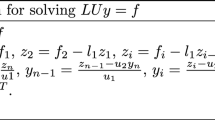Abstract
We propose efficient fast Fourier transform (FFT)-based algorithms using the method of fundamental solutions (MFS) for the numerical solution of certain problems in planar thermoelasticity. In particular, we consider problems in domains possessing radial symmetry, namely disks and annuli and it is shown that the MFS matrices arising in such problems possess circulant or block-circulant structures. The solution of the resulting systems is facilitated by appropriately diagonalizing these matrices using FFTs. Numerical experiments demonstrating the applicability of these algorithms are also presented.






Similar content being viewed by others
References
Aliabadi, M.H.: The Boundary Element Method. Applications in Solids and Structures vol. 2. Wiley, London (2002)
Bialecki, B., Fairweather, G., Karageorghis, A.: Matrix decomposition algorithms for elliptic boundary value problems: a survey. Numer. Algorithms 56, 253–295 (2011)
Chen, W., Gu, Y.: An improved formulation of singular boundary method. Adv. Appl. Math. Mech. 4, 543–558 (2012)
Davis, P.J.: Circulant Matrices. Wiley, New York (1979)
Fairweather, G., Johnston, R.L.: The method of fundamental solutions for problems in potential theory. In: Treatment of Integral Equations by Numerical Methods, pp. 349–359. Academic Press, London (1982)
Fairweather, G., Karageorghis, A., Martin, P.A.: The method of fundamental solutions for scattering and radiation problems. Eng. Anal. Bound. Elem. 27, 759–769 (2003)
Golberg, M.A., Chen, C.S.: Discrete Projection Methods for Integral Equations. Computational Mechanics Publications, Southampton (1997)
Golberg, M.A., Chen, C.S.: The method of fundamental solutions for potential, Helmholtz and diffusion problems. In: Golberg, M.A. (ed.) Boundary Integral Methods: Numerical and Mathematical Aspects. Comput. Eng., vol. 1, pp. 103–176. WIT Press, Boston (1999)
Karageorghis, A., Lesnic, D.: The pressure-streamFunction MFS formulation for the detection of an obstacle immersed in a two-dimensional Stokes flow. Adv. Appl. Math. Mech. 2, 183–199 (2010)
Karageorghis, A., Lesnic, D., Marin, L.: A survey of applications of the MFS to inverse problems. Inverse Probl. Sci. Eng. 19, 309–336 (2011)
Karageorghis, A., Smyrlis, Y.-S.: Matrix decomposition MFS algorithms for elasticity and thermo-elasticity problems in axisymmetric domains. J. Comput. Appl. Math. 206, 774–795 (2007)
Karageorghis, A., Smyrlis, Y.-S., Tsangaris, T.: A matrix decomposition MFS algorithm for certain linear elasticity problems. Numer. Algorithms 43, 123–149 (2006)
Kołodziej, J.A., Zieliński, A.P.: Boundary Collocation Techniques and Their Application in Engineering. WIT Press, Southampton (2009)
Marin, L., Karageorghis, A.: MFS-based solution to two-dimensional linear thermoelasticity problems. In: Brebbia, C.A., Poljak, D. (eds.) Thirty-Fourth International Conference on Boundary Elements and Other Mesh Reduction Techniques (BEM/MRM 34), pp. 39–49. WIT Press, Southampton (2012)
Mathon, R., Johnston, R.L.: The approximate solution of elliptic boundary-value problems by fundamental solutions. SIAM J. Numer. Anal. 14, 638–650 (1977)
de Medeiros, G.C., Partridge, P.W., Brandão, J.O.: The method of fundamental solutions with dual reciprocity for some problems in elasticity. Eng. Anal. Bound. Elem. 28, 453–461 (2004)
Smyrlis, Y.-S., Karageorghis, A.: Some aspects of the method of fundamental solutions for certain harmonic problems. J. Sci. Comput. 16, 341–371 (2001)
Tsai, C.C.: The method of fundamental solutions with dual reciprocity for three-dimensional thermoelasticity under arbitrary forces. Eng. Comput. 26, 229–244 (2009)
Tsangaris, Th., Smyrlis, Y.-S., Karageorghis, A.: Numerical analysis of the method of fundamental solutions for harmonic problems in annular domains. Numer. Methods Partial Differ. Equ. 22, 507–539 (2006)
Acknowledgements
The financial support received from the Romanian National Authority for Scientific Research (CNCS–UEFISCDI), project number PN-II-ID-PCE-2011-3-0521, is gratefully acknowledged.
Author information
Authors and Affiliations
Corresponding author
Appendix A
Appendix A
The following lemma establishes that the matrices A 21 and A 22 in (5.3) in the case of boundary conditions (2.1c) are circulant.
Lemma 1
The matrix
is circulant.
Proof
We consider the collocation points
and the singularities

Then clearly,
where \({\boldsymbol{n} }_{k}=(n_{1_{k}},n_{2_{k}})\) is the outward normal vector at the boundary point \((x_{1_{k}}, x_{2_{k}})\), We shall show that both the numerator and the denominator on the right hand side of (A.3) are circulant which yields the required result. Using expressions (A.2) and (A.3), the numerator \((x_{1_{k}}-\xi_{1_{l}}) {n_{1}}_{k} +(x_{2_{k}}-\xi_{2_{l}}) {n_{2}}_{k}\) becomes

which only depends only on l−k, hence the quantity is circulant.
Similarly, the denominator \((x_{1_{k}}-\xi_{1_{l}})^{2} + (x_{2_{k}}-\xi_{2_{l}})^{2}\) becomes

which again depends only on l−k and is therefore circulant. □
The following lemma establishes that the matrices \(\tilde{B}_{21}\) and \(\tilde{B}_{22}\) in (5.10) are block circulant.
Lemma 2
Let
Then

If k+j>N (respectively l+j>N) then k+j is replaced by k+j−N (respectively by l+j−N).
Proof
We shall first prove the results for ℓ 1=ℓ 2=ℓ. Using the notation \(\alpha_{\ell_{1}}=\alpha_{\ell_{2}}= \alpha_{\ell }=\alpha\),
from (3.4), by differentiation, we get

and
Now, from (3.8) we obtain



and

Following [12, Lemma 3.1], it is sufficient to show that

Now, since
and the coordinates of the singularity ξ l are
it follows that

From the expressions for the traction fundamental solutions, we obtain that


and


First we want to show, from Eqs. (A.5) and (A.12), that


and

In addition,

Finally,

and

From (A.17), (A.18) and (A.19), it easily follows that (A.16) holds.
Next we want to show, from Eqs. (A.8) and (A.15), that

We have that,

From (A.17), (A.19) and (A.21), it easily follows that (A.20) holds.
Next we want to show, from Eqs. (A.6) and (A.13), that

We have that

and

Clearly, from (A.19), (A.23), (A.17), (A.18) and (A.21), it follows that (A.22) holds.
Finally, we want to show, from Eqs. (A.7) and (A.14), that

Again, from (A.19), (A.23), (A.17), (A.18) and (A.21), it follows that (A.24) holds.
The proof for the case ℓ 1≠ℓ 2 is identical if instead of (A.4) we take
□
Rights and permissions
About this article
Cite this article
Karageorghis, A., Marin, L. Efficient MFS Algorithms for Problems in Thermoelasticity. J Sci Comput 56, 96–121 (2013). https://doi.org/10.1007/s10915-012-9664-x
Received:
Revised:
Accepted:
Published:
Issue Date:
DOI: https://doi.org/10.1007/s10915-012-9664-x




